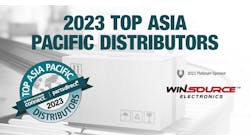After grappling with persisted supply chain disruptions, labor constraints and rising business costs in 2022, electronics distributors welcomed 2023 with open arms. While some of the roadblocks they were facing have since eased – the global chip shortage being one of them (at least for some sectors) – a host of new challenges were waiting right around the corner. High inflation, rising interest rates and recessionary fears are top of mind for many companies right now. The ongoing war in Ukraine, the spate of U.S. bank failures and a labor shortage that appears to be here to stay are also keeping many distributors up at night right now.
According to the Labor Department, the labor market added 253,000 payrolls in April, at which point the national unemployment rate dipped to a historically low 3.4%. For context, economists were only expecting employers to add about 185,000 jobs in April – an estimate that exceeded the 165,000 jobs that were added in March. As job growth continues to boom, it’s the latest sign that the U.S. economy continues to have strong momentum.
Best described as a “mixed bag,” the business environment right now is replete with challenges and opportunities. While the cost of goods, labor and shipping may all be straining distributor margins, the loosening up of the semiconductor supply chain and high demand for certain product categories are setting the stage for more positive momentum in 2023.
2023 Top 50 Electronics Distributors List >
Tim Carroll, Digi-Key’s (#5 on the 2022 Top 50) global head of marketing and e-commerce, says some of the new market trends that the distributor is seeing so far in 2023 include higher demand for wireless connectivity, industrial automation and electrification, smart sensors, cross architecture solutions and rapid prototyping. “In the past year there’s been a surge in new product introductions in every industry from automotive to medical, industrial automation to consumer devices and everything in between, driving business across the board,” Carroll says.
Asked how inflation, the rising costs of business and the labor shortage are impacting Digi-Key, Carroll says the company is constantly looking at ways to engrain automation into everything it does. “We want to ensure we can continue to service our customers at the high level they expect, even with the rising costs of inflation,” Carroll says. “Our new 2.2 million square foot nearly fully automated warehouse will help us continue to scale during these times of labor shortages as well.”
Year-Over-Year Comparisons
Combined, the top five distributors on this year’s Top 50 Distributors list posted revenues of over $92 billion in 2022, which was $2.75 million higher than the top five’s revenues the prior year. For the most part, distributor revenues were consistent with 2021, though some companies posted significant revenue increases in 2022. The top two distributors on the list – Arrow and WPG Holdings Ltd. – both posted losses for the overall year.
However, Avnet (#3) posted revenue gains in 2022, while Future Electronics (#4) remained flat, and Digi-Key (#5) saw its revenues rise. The total revenues for the next five entrants (Smith, Mouser, TTI Inc., Allied Electronics, Inc., and NewPower Worldwide) reached nearly $18 billion in 2022, with four out of five of those distributors experiencing year-over-year revenue increases in 2022. Total sales for the 45 different electronics distributors that reported their revenues to Supply Chain Connect for this year’s chart hit $120 billion – a slight increase over 2021’s total sales of $119 billion.
Tracking Economic Activity
Economic activity in the manufacturing sector contracted in April for the sixth consecutive month following a 28-month period of growth, say the nation’s supply executives in the latest Manufacturing ISM Report On Business.
“The April Manufacturing PMI registered 47.1%, 0.8 percentage point higher than the 46.3% recorded in March,” said ISM’s Timothy R. Fiore, in the press release. “Regarding the overall economy, this figure indicates a fifth month of contraction after a 30-month period of expansion.”
According to ISM, the New Orders Index remained in “contraction territory” at 45.7% , 1.4 percentage points higher than the figure of 44.3% recorded in March. The Production Index reading of 48.9% is a 1.1-percentage point increase compared to March’s figure of 47.8%. The Prices Index registered 53.2%, up 4 percentage points compared to the March figure of 49.2%. And, the Backlog of Orders Index registered 43.1%, 0.8 percentage point lower than the March reading of 43.9%.
Two of the six biggest manufacturing industries – Petroleum & coal products and transportation equipment – both registered growth in April. “The U.S. manufacturing sector contracted again; however, the Manufacturing PMI improved compared to the previous month, indicating slower contraction,” Fiore adds. “The April composite index reading reflects companies continuing to manage outputs to better match demand for the first half of 2023 and prepare for growth in the late summer/early fall period.”
Reset Back to Normalcy
Jeff Ittel, EVP at Flip Electronics (#29), says 2022 started out on the same trajectory as 2021 did. “Revenues grew quite nicely through the first two quarters and started to slow down in the second half of the year,” he says. “Some segments held up nicely, namely industrial and automotive, with IT-related segments slowing down rapidly.”
Asked what challenges Flip is currently working through, Ittel says the company is still dealing with “pockets of shortages” with many of its customers. Right now, the purchasing motion has slowed down as buyers are feeling more confident in their ability to find products with shorter lead times.
“Balancing inventory levels as lead times come down is now the name of the game in distribution,” Ittel says, who notes that Flip focuses on end of life (EOL) and obsolescence. “We’re spending a lot of effort working with suppliers who are using the slowdown to focus on driving efficiencies, as they now have time to spend on something else other than expedites and shortage calls.”
Ittel says that while activity remains “fairly robust” right now, 2023 may be a bit of a reset back to normalcy. “We should start to see some growth – albeit not at the 2021-22 levels – as we head into 2024,” he concludes.
Delivering Equitable Solutions to Customers
Matt Fonstein, Chief Trade Officer at NewPower Worldwide (#11), says business was “incredibly strong” in 2022 and that the company saw very high demand for its services. Despite the supply chain shortages that were impacting the market, NewPower leveraged its long-term relationships with manufacturers and other authorized distributors to ensure that its own customers’ needs were met. “Those relationships that we built really paid off when 2022 hit,” Fonstein says.
NewPower was also equipped with a substantial committed credit facility backed by some of the world’s largest banks. “That [gave] us the financing necessary to complete some very large deals,” Fonstein explains. “Customers were very confident in what we could offer and knew that if they gave us a multimillion-dollar purchase order, we could support it and deliver it without issue.”
Coming into 2023, Fonstein says that shortages continued but began to wane. Some product prices have receded and NewPower’s customers are taking advantage of the savings. “That’s somewhat different than what was happening in 2022,” he says. “We now have a bit more ability to save our customers money.”
2023 Top 50 Electronics Distributors List >
Looking ahead, Fonstein sees some industry transformation on the near horizon. “We’re seeing high demand for our solutions and we’re signing new contracts on a regular basis that have us involved up and down the supply chain – and not just from a buy-sell standpoint,” Fonstein says. “Whether it’s delivering on shortages, coming up with creative solutions or solving a unique customer problem, our team of industry experts can quickly assess a problem, understand the customer’s needs, and then deliver an equitable solution.”
Sustainability Counts
As part of its continued commitment to sustainability, Digi-Key has an Environmental Management System that’s ISO 14001 certified. The massive roof on its brand-new Product Distribution Center expansion (PDCe) is white to reflect the sun’s heat. “As we built our new PDCe, sustainability was top of mind, and we’ve designed every aspect for on-demand automation – anything that requires power is only used when needed,” Carroll says. For example, the new facility uses all sensor-activated LED lights as well as high-efficiency water heaters to conserve energy.
The company also uses as much paper-based recycled materials as possible in its packaging. “We consolidate customers’ orders to ship everything in one box to reduce packaging materials, space, fuel used to ship and shipping costs,” Carroll says, who anticipates more innovation on Digi-Key’s part this year.
“We see 2023 as the year designers and engineers get back to innovating. While some supply challenges will still be there, engineers are ready to get back to new design challenges, and Digi-Key is ready to support them in their new endeavors,” Carroll says, who points out that the electronics industry is “cyclical by nature.” Having just experienced a few years of intense demand, the company is fully prepared for a natural tapering off, should that occur.
“The demands and challenges of the past two years will come back around again in new forms in the future, and we’ll be better prepared with the new building blocks that we’ve put in place,” Carroll says. “We’re committed to ongoing capital investment, additional capacity expansion and creating a frictionless digital experience for customers, building on the foundation from the last three years.”
An Interesting Year for Semiconductors
Colin Strother, Executive Vice President at Rochester Electronics (#18) calls 2022 “an interesting year” for the semiconductor industry. While the forecast for global industry growth was revised downwards several times from its initial value of 10%, he says the consensus is that overall annual growth was in the range of 4%, bringing the total industry value close to $600 billion.
Calling the semiconductor industry “famously cyclical,” Strother says the U.S. CHIPS Act sparked $200 billion dollars in investments for U.S. semiconductor production, according to the Semiconductor Industry Association. “Since the founding of Rochester Electronics in 1981, we recall about 20 industry cycles of varying magnitude, each with different causes and conclusions,” Strother adds. “They all tend to abruptly start and end.”
Strother says Rochester Electronics anticipates continued supply chain disruptions in 2023. While the overall market may decline, he adds, shortages are likely to affect only specific categories, with others having oversupply. “Safe stocks and multi-sourcing are back in vogue,” he says. Buyers should continue to plan for future supply disruptions and secure relationships with authorized partners that can provide “risk-free stock during times of shortage,” Strother adds.
2023 Top 50 Electronics Distributors List >
According to Strother, Rochester Electronics is committed to the preservation of the environment and full compliance with all relevant environmental laws and regulations. “We foster this commitment through the implementation of environmentally sustainable processes, pollution prevention practices and a continual improvement focus on our manufacturing and distribution operations,” he says.
Waste reduction is a top priority for Rochester Electronics, whose recycling programs capture waste metals and remove them from the waste stream. “Intensive chemical analysis is performed within our manufacturing program to optimize performance and reduce waste wherever possible,” Strother says. “All hazardous waste is 100% designated ‘Zero Waste to Landfill.’ This means all hazardous waste created is recycled, reclaimed or reused, never to be buried in a landfill and left as legacy waste.”
Looking ahead to 2023, Strother says major international financial services and advisory giants, KPMG and the Global Semiconductor Association have all highlighted wireless communications, automotive and the Internet of Things (IoT) as key drivers for the semiconductor industry. “We believe that Rochester’s authorized solutions well-position us to firmly support our supplier partners and customers in these and other industries,” he adds.
The Pendulum is Swinging
After a two-year period of dealing with extended lead times, undersupply and unwavering demand due to the COVID pandemic, Fusion Worldwide (#10) has found itself operating in a market where the pendulum has swung towards oversupply and weakened demand. “In 2023, we’re seeing customers needing different services,” says Chief Revenue Officer Luke LeSaffre. “Instead of just supply requests, they are also looking for support with inventory management and excess supply mitigation as they try to balance a renewed focus on resiliency and cost reduction, prioritizing effectiveness.”
This year, LeSaffre says Fusion anticipates a shift to a more normalized market – where supply exceeds demand – where cost-saving opportunities are created by excess inventory. This is a departure from sourcing during a challenging market with high demand and low supply, he adds. He’s also seeing increased demand for electric vehicle (EV) chips.
“As demand surges, forecasts suggest that EV sales will continue to increase dramatically and could account for more than 50% of total U.S. car sales by 2030,” LeSaffre explains. “The anticipated spikes are due to factors like improving vehicle range and more model variety, as well as new federal legislation that incentivizes the use of electric vehicles through tax credits.”
And with that demand increase comes a significant jump in production and a rising need for semiconductor chips for electric vehicles.
Fusion takes its own ESG responsibilities seriously by maintaining its ISO 14001 certification and actively working on several new ESG initiatives. Many of these are project-based and include actions such as the use of sustainable packaging. “We’re constantly looking for ways to cut down the use of packaging materials through rightsizing and the implementation of reusable materials,” LeSaffre says. “We’ve also been working tirelessly to cut down on waste company-wide and cutting fossil fuel use through energy efficiency programs globally.”
Going forward, LeSaffre expects the dynamic nature of the semiconductor market to keep electronics distributors and buyers on their toes. “It’s impossible to achieve complete supply and demand equilibrium in today’s multi-dimensional supply webs, which are characterized by complex outsourcing, specialization and intricate chip manufacturing,” he says. “In other words, we’re likely to always have either a shortage or excess of semiconductors in at least one industry, with an ever-changing market structure.”








